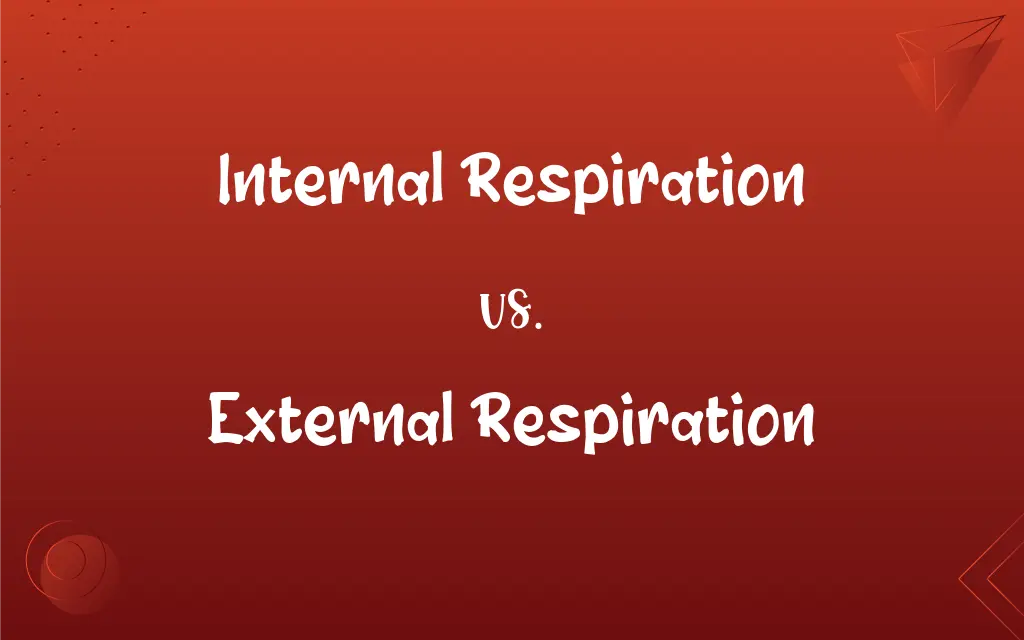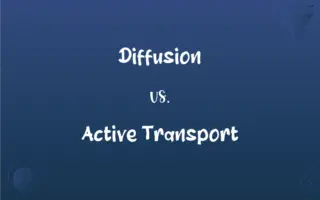Internal Respiration vs. External Respiration: What's the Difference?
Edited by Janet White || By Harlon Moss || Updated on October 27, 2023
Internal respiration is the exchange of gases between blood and body tissues. External respiration is the exchange of gases between the external environment and the blood in the lungs.

Key Differences
Internal respiration involves gas exchange at the cellular level, whereas external respiration occurs in the lungs.
Internal respiration is crucial for cellular metabolism, while external respiration is essential for oxygen intake and carbon dioxide expulsion.
In internal respiration, oxygen is delivered to tissues, and carbon dioxide is picked up; in external respiration, oxygen is absorbed, and carbon dioxide is released into the atmosphere.
Internal respiration occurs throughout the body, while external respiration is limited to the respiratory system.
The efficiency of internal respiration depends on circulatory health, whereas external respiration relies on lung function.
ADVERTISEMENT
Comparison Chart
Part of Speech
Noun
Noun
Word Origin
Latin (internus + respiratio)
Latin (externus + respiratio)
Plural Form
Internal respirations
External respirations
Related Terms
Cellular respiration, Gas exchange
Pulmonary ventilation, Breathing
Usage in Biology
Cellular metabolism, Oxygen delivery
Oxygen intake, Carbon dioxide release
ADVERTISEMENT
Internal Respiration and External Respiration Definitions
Internal Respiration
The exchange of respiratory gases within tissues.
Internal respiration occurs in the capillaries surrounding body tissues.
External Respiration
Oxygen intake and carbon dioxide expulsion through the lungs.
During exercise, external respiration rates increase.
Internal Respiration
Oxygen and carbon dioxide transport within the body.
Efficient internal respiration is vital for energy production.
External Respiration
The respiratory activity occurring in the alveoli of the lungs.
External respiration is impaired in lung diseases.
Internal Respiration
Gas exchange between blood and body cells.
Internal respiration supplies oxygen for cellular activities.
External Respiration
Gas exchange between lungs and the external environment.
External respiration involves inhaling oxygen and exhaling carbon dioxide.
Internal Respiration
The process of oxygen utilization and carbon dioxide production at the cellular level.
Internal respiration is fundamental for cellular metabolism.
External Respiration
Breathing process involving the respiratory system.
External respiration is essential for life-sustaining oxygen intake.
Internal Respiration
Cellular level respiration involving blood and tissues.
Internal respiration ensures cells receive adequate oxygen.
External Respiration
The process of air movement in and out of the lungs.
External respiration efficiency is crucial for athletic performance.
FAQs
What is external respiration?
Exchange of gases between the lungs and the external environment.
Where does internal respiration occur?
At the cellular level in body tissues.
Why is internal respiration important?
For delivering oxygen to cells and removing carbon dioxide.
Where does external respiration happen?
In the lungs.
Can internal respiration occur without external respiration?
No, both are interdependent.
Is external respiration the same as breathing?
Essentially, yes.
What's the role of alveoli in external respiration?
They facilitate gas exchange with the blood.
Can illnesses impact external respiration?
Yes, respiratory diseases can severely impair it.
What is internal respiration?
Exchange of gases between blood and body tissues.
What can impair internal respiration?
Poor blood circulation or cellular damage.
Can diseases affect internal respiration?
Yes, conditions like anemia can impact it.
Do plants perform external respiration?
In a way, through gas exchange in leaves.
Why is external respiration crucial?
For oxygen intake and carbon dioxide release.
What factors affect external respiration?
Lung function, air quality, and respiratory rate.
Is internal respiration synonymous with breathing?
No, it's a cellular process, not a mechanical one.
Does exercise influence internal respiration?
Yes, by increasing oxygen demand and carbon dioxide production.
How does exercise affect external respiration?
It increases the rate and depth of breathing.
Do plants undergo internal respiration?
Yes, at a cellular level.
Does external respiration affect internal respiration?
Yes, as it determines oxygen availability.
What role does hemoglobin play in internal respiration?
It transports oxygen to tissues and carries carbon dioxide back.
About Author
Written by
Harlon MossHarlon is a seasoned quality moderator and accomplished content writer for Difference Wiki. An alumnus of the prestigious University of California, he earned his degree in Computer Science. Leveraging his academic background, Harlon brings a meticulous and informed perspective to his work, ensuring content accuracy and excellence.
Edited by
Janet WhiteJanet White has been an esteemed writer and blogger for Difference Wiki. Holding a Master's degree in Science and Medical Journalism from the prestigious Boston University, she has consistently demonstrated her expertise and passion for her field. When she's not immersed in her work, Janet relishes her time exercising, delving into a good book, and cherishing moments with friends and family.































































